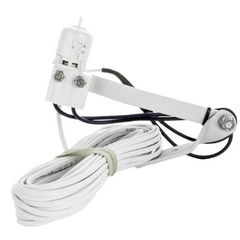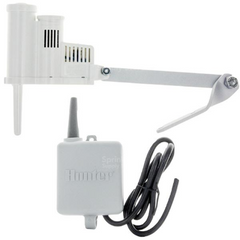Free Shipping orders over $149
Free Shipping
on all orders over $149

Picking an excellent rain sensor for an irrigation system can sometimes be challenging. A rain sensor essentially determines if a sufficient amount of rainfall has occurred to skip the irrigation cycle. Be it for any backyard or businesses; it is exceptionally crucial to install sensors that limit the sprinkler system from unnecessarily running in the rain.
The location of the installed rain sensor is also conditional on its connection with the controller. There are two types to choose from, the wired and wireless sensors.

It requires less maintenance. The wired rain sensor requires you to run the wire between the sensor and the sprinkler system controller. It means you need to install the wired sensor in a location that will enable you to run the wire presentably or without exposing it to being cut by a lawn mower or other devices. Spread the wires out between the sensor and the controller to establish that there is sufficient length for proper connection.

Wireless systems use different radio methods to transfer signals between the sensor and the controller. Wireless sensors can be installed up to 500 feet away from the irrigation system. It permits you to mount it in more places and makes the installation look nicer and is easier to install since there is no need to worry about running the wire from the sensor to the sprinkler custom controller. These systems also provide adjustable rain sensitivity, which will enable owners to tailor the sensor for extreme climate and specific water needs.
There is a remarkable amount of money that can be saved by installing rain sensors. The lesser these parts function during the rainy season, the more extended chance the system will tend to last. Rain sensors are highly essential in contributing to the prospective lifespan of the irrigation system. Here is a list of the most outstanding, and trusted brands available in the market:
When a significant amount of rainwater prompts the sensor, the electrical link between the sensor and the system controller is suspended hinting at the activity. The sensor interrupts the electrical connection only to avoid the electricity from running to either the sprinkler valves or to a pump start.
The Hunter Mini-Clik, Rain-Clik, and Wireless Rain-Clik are compatible with all brands of irrigation controllers and can be installed by a professional irrigation contractor. Law requires rain sensors in some areas, so it is an excellent idea to check with a contractor or any local water authority before considering an irrigation system installed.
Even if a sensor is not needed, it is very beneficial to have one on your system. It helps to save water by interrupting any automatic cycles scheduled after enough accumulation of rain has occurred. It does not only saves money but can help to make sure that plants are not over watered and can keep you from the mistake of sprinkling while it is raining.
Most rain sensors work by accumulating a set amount of rainfall (⅛ inch, up to a ¾ inch) before a switch is activated that interrupts the circuit from the controller and shuts off the system. In that “accumulation time”, the system will unnecessarily continue to water. This can look especially bad for conservation-conscious municipalities, businesses, and residences. With built-in Quick Response technology, the Hunter Rain-Clik and Wireless Rain-Clik can command a controller to shut off right when it starts to rain.
Hunter Industries has a unique device that can be installed in combination with any brand of rain sensors or added to the system after installation. When installed with a rain sensor, the Hunter Clik-Delay is designed to delay controller activation for 48 hours after the rain has stopped.
Rain sensors are easy to operate and do not require complicated wiring. It simply links with the existing system already in place on any commercial property. Why do you need one? Rain sensors are very convenient and one of the very best ways to maintain an irrigation system working smoothly and efficiently. Most rain sensors are compatible with all brands of irrigation controllers and can easily be installed by yourself, or by a professional irrigation contractor.
A rain sensor will not only save you money but can help to make sure that plants are not over watered and can keep you from the embarrassment of watering while it is raining.
Florida is the only state in the nation with a rain sensor statute. Beginning in 1991, this statute applies to all new automatic sprinkler systems: "Any person who purchases and installs an automatic lawn sprinkler system after May 1, 1991, shall install, and must maintain and operate, a rain sensor device or switch that will override the irrigation cycle of the sprinkler system when adequate rainfall has occurred" (Florida Statute 373.662). Some Florida counties and communities have passed laws stating that all automatic landscape irrigation systems require rain sensors, regardless of age. Some cities, including Cary, North Carolina, have ordinances requiring rain sensors.
Probable Water and Cost Savings
The specific amount of the potentially saved water when utilizing the rain shut-off devices varies, however, savings are usually substantial within a year with average rainfall. There are numerous factors involved in determining the value of a sensor in reducing water usage: how frequently it rains, whether or not the controller is purposely turned on for automatic operation, and the volume of water applied by the system per cycle. If the water costs and the amount of water applied per watering cycle by the whole system are distinguished, it is simple to calculate the value of the money saved each time the sensor intervenes the watering cycle because of rainfall.
As an example, if a system irrigates 1 acre (4,046 square meters) of turf and is set to run each zone so that 1 inch (2.6cm) of water is utilized per cycle, one can calculate that 27,152 gallons (102.8 m3) are being applied over the 1 acre (4,046 square meters) of turf per cycle. Considering water costs $2.00 per thousand gallons, the saved money will be worth $54.30 whenever the sensor eliminates an irrigation event. What is even more critical, 27,152 gallons (102.8 m3) that would be lost to deep percolation or runoff will be saved. If this amount is multiplied by the number of significant rainfalls that occur in the area over one growing season, a considerable amount of money and water can be saved.
If unsure where to place and install the rain sensors within your property, it is best recommended to seek for professional help.
First and foremost, you must select where to place the sensors. Recommended in an open area which is precisely not blocked by trees, roof, or almost anything else that can prevent rainwater from getting in contact with the sensor.
For wired sensors, the device must be installed near the sprinkler controller and, make sure that the wires are securely linked inside the controller’s valve wiring panel.
The modern types usually come with two sensor wires. Connect these wires to the sprinkler controller’s rain sensor terminals. Then, connect one wire to the common wire using a nut, and the other wire needs to be linked to the common terminal. Follow the manual thoroughly and carefully before going through the whole procedure.
There is no necessary maintenance for the unit. The Mini-Clik does not have to be transferred or covered for “winterizing” purposes.
Follow these simple tests first before assuming the unit is bad and replacing it. If the system will not come on at all:
If the System Will Not Shut Off Even After Heavy Rainfall:
Installing a rain sensor is very easy & simple. Only a few tools are required, and instructions are included with every sensor.
Using the screws included within the package, mount the sensor on any surface where exposed to rainfall, but out of range of the sprinkler spray. The switch housing part must be upright, but the swivel-bracket can be moved for mounting on an angled surface. Loosen the locknut and screw before turning the bracket, then re-tighten.
There are plenty of ways to order an irrigation rain sensor. Wired sensors are cheaper and range from $25 to $50 due to the limited area that can be covered while wireless sensors are more expensive that range from $75 to $200, it offers easy installation and more capability.